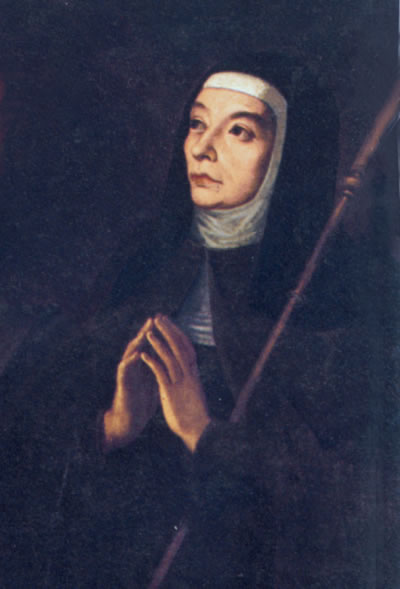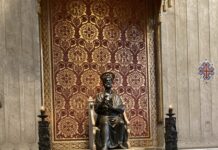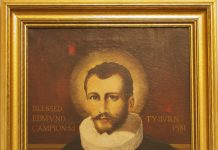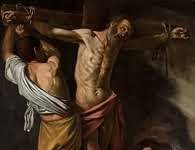Jerónima Maria Agnese, was born on the first day of September 1592 in Barcelona, the last of four children who were born to Cristobál Astorch and Caterina. Unfortunately for Jerónima Maria, her mother died when she was just twelve months old, and the little girl was entrusted to a nurse. She was then orphaned by her father at the age of five or six years.
In the meantime, Jerónima Maria’s sister, Isabel, followed a group of young people who were fascinated by the spirituality of the Capuchin Poor Clare Angela Serafina Prat. Jerónima was attracted to this way of life, being drawn to the Capuchin cloistered life since she was seven years old. Due to her eating of bitter almonds she was on the point of dying. As they were preparing her body for her funeral Mother Serafina intervened and the little Jerónima came to and was saved. Later on in her life she would write about this incident: My childhood ended when I was seven. From then on I was already a judicious and adroit woman, and therefore patient, measured, silent and truthful.
At nine years of age she started studying. Jerónima mastered reading, writing and also the usual work given to women in those days. Her passion was books in Latin. Seeing this little girl so studious great plans immediately started circling her future. Nevertheless, Jerónima’s desire was to emulate the example of her sister and enter the Monastery. Following some opposition from her family together with the fact that for eleven years of age she was mature enough to face the task, Jerónima set sail for this adventurous voyage in following the Lord Jesus in the footsteps of St Clare of Assisi.
September 16, 1603 was the day of her official entrance to the Capuchins, carrying with her six volumes of Latin breviary (!). The name chosen for her religious consecration was Maria Angela. She was accompanied by the great confessor and hermit Martin Garcia. In everything, Mother Angela Serafina Prat was united together with her sister Isabel. It needs to be said that Sister Victoria Fábregas was very strict with the little sister Maria Angela, challenged as she was by the intelligence of the little novice, fearing her not to be humble. For this reason, sister Maria Angela had to put aside the Latin books. Nevertheless Latin simply went out from her lips filled with knowledge of the Bible, the Fathers and the Breviary. Hers was an infused knowledge which later on theologians and some bishops were to acknowledge.
After spending some five years as an aspirant, Sister Maria Angela started her novitiate under the balanced and detached direction of her sister as novice mistress. Her experience was marked with afflictions, temptations and playing the role of ‘little teacher’ to her novitiate companions. It was on September 8, 1609, feast of the nativity of Mary, that Maria Angela made her temporary profession into the hands of Sister Caterina de Lara, who was the successor to the founder.
Concurrently, the new Capuchin congregation grew at a stimulating pace. Mother Maria Angela, together with five sisters, were sent to establish a monastery at Zaragoza. The latter monastery was to become the core from where the Capuchin Poor Clares were to infiltrate the whole Spain. Then, on 19th of May 1614, this same group of sisters headed straight to Zaragoza. Now, Sister Maria Angela had the mission of novice master and also that of a secretary. Yet, the separation from her sister was a dear cost to be paid. In fact, her sister would leave this valley of tears only two years later at the young age of thirty six. The journey was made more catastrophic when the carriage and horse capsized. Whilst in the new Our Lady of the Angels monastery, sister Maria Angela was the formator of a generation of Capuchin Poor Clares.
Sister Maria Angela became a vicar in 1624, and three years later she also was made abbess. Nevertheless she maintained the role of ‘choir corrector’, in other words the one responsible for the correctness of ceremonies as well as the dignity of the liturgy of the hours in the community. The moment she started her office, Mother Maria Angela had the joy of obtaining the official approval from Urban VIII for the constitutions of the Capuchin Poor Clares of Spain. Being aware of the significance of knowledge for its rule with the intent of sanctifying the institute, Mother Maria Angela wisely emphasized on the importance that her sisters study the rule regularly. For this reason, the rule in her monastery was ready publicly in the refectory at the beginning of each month. Thanks to this custom even illiterate sisters could listen and learn it by heart. Mother Maria Angela was so anointed by the Holy Spirit and spoke so well that a bishop lamented the fact that she was not a priest.
Her maternal style of governing the monastery made Mother Angela being present in the kitchen, the laundry, the infirmary as well as in the garden. Her immediate reply at why she did this was the following: Because I would even give you my life. Mother Maria Angela made her monastery a home of solidarity with those who were suffering in the outside world. She would share the monastery alms with the poor and generously aid the needy with the little money the monastery had at its disposal. In those days Zaragoza was occupied by ragged refugees coming from the rebellion in Catalonia. Mother Maria Angela took the opportunity to allot to some of them the clothes the novices brought over when they left their homes. Hers was a biblical and liturgical spirituality fully impregnated with the mysteries of Christ and His Mother Mary, the angels together with the saints.
With how much familiarity she used to call the saints. In her prayers twelve saints, the heavenly consistory, as she used to call them, were her favourites. They were for Mother Maria Angela teachers and advocates for the virtues and concrete needs. These incldued Saint John the evangelist, a model of love; Saint Francis of Assisi a model of perfect faithfulness to the Rule; Saint Benedict a model for purity; her holy mother Saint Clare a model in every form of perfection. The Breviary remained to influence and envelop her spiritual life ever more continuously. In 1642 she wrote, It happens to me very, very often that while singing the psalms the Lord communicates with me through interior sensations that which I am signing is such a way that I can say that I am truly singing the internal feelings of my spirit and not the letter of the psalms. It seemed to me that Lord had made himself my teacher and expounder of what I was saying and singing, enabling me to understand some of the infinite truths of the Sacred Scripture.
Mother Maria lived in Zaragoza for thirty years. Under her charismatic leadership the community increased not only in number but also in quality too. Her ardent desire to increase the Order occurred was in part due to a blasphemous as well as heinous act which took place in Barcelona at the hands of Louis XIV troops, who had profaned some churches. As a response to this sacrilegious act, a pious canon by the name of Alejo de Boxadós had the idea of building a Poor Clare Monastery. The title for this monastery would be Exaltation of the Blessed Sacrament. To materialize his idea he talked to the Capuchin Poor Clares. As a result of this contact on June 2, 1645, under the direction of Mother Angela Astorch, five sisters went with the canon to Murcia. Even here the journey was difficult, as the coach driver fell asleep and found himself under the coach’s wheels. It was the sister’s faith which brought him to life and they kept journeying on. The monastery was inaugurated with a solemn procession with the Blessed Sacrament in Murcia, in concordance with the reflections of Blessed Maria Angela who saw the whole of Christology which was epitomized in the Eucharist. Mother Maria Angela managed to introduce the daily Communion praxis among her sisters.
As time went on, the monastery became a hub of spirituality. At the time of the plague in 1648, the sisters were saved just as they were saved from the periodic floods of the Segura River in 1651, even though the monastery suffered a lot. In this situation the sisters had no other alternative other than to take refuge in the summer residence of the Jesuits in the mountains for some thirteen months. In the meantime the monastery underwent the necessary restoration work. On September 22nd, 1652 was the day when they finally returned to the monastery, even if the one year after they again had to resort themselves to the mountains once again due to another flood. During this time Blessed Maria Angela was the object of a defamatory accusation. In spite of this, her innocence immediately came to light.
When she got back to the monastery Mother Maria Angela kept serving in the office of abbess till her death in 1661. At that time she was in her seventies. Her only wish was to step down altogether so as to be “sola con il Solo” (that is alone with Him alone). Blessed Maria Angela became unfit for the performance of different works and thus she could spend more time to contemplative life. Towards mid November 1665 Maria Angela, after having some moments of epilepsy, got her memory and intelligence back. Nevertheless, she approached the end of her life, and in her suffering sometimes she would sing the Pange lingua while waiting for her “bridegroom” [“blood bridegroom” cf. Ex 4:24] who did come for her on 2 December 1665. She was seventy five years old.
Pope Saint John Paul II added her with the list of the blessed on 23rd of May 1982. Blessed Maria Angela Astorch can be regarded as one of the most significant links in the history of devotion to the Child Jesus, to the Sacred Heart, the Eucharist, to the Passion and Christ the Good Shepherd from which comes the entire Capuchin Marian spirituality of the “Divine Shepherdess” or Divina Pastora.
From the following unpublished manuscript found in the archives of the General Postulator OFM Cap which Blessed Maria Angela Astorch wrote, there emerges crystal clear the maternal and fraternal spirit which she showed in her total service to her sisters. She writes:
It is the greatest mortification for me to find myself the superior and having to give orders, especially because I am responsible for the spiritual progress of the sisters. I heard the Lord telling me inwardly: “In everything you do, make yourself an example to them”, and from this I have never ceased to learn more about my obligation to be an example to the that governance involves, as a servant in the Lord’s house and judging myself unworthy to be among his servants.
I know very well that the Lord does not lead everyone by the same route, and that therefore l have help them, gently and kindly, at the pace which He has decided for each one, without trying to regiment them and direct them all in the same way. My usual way of acting is to do everything under the gaze of my divine Lord. If I suffer I accept it, exercise patience, and say nothing, I renounce my own pleasure, my will, and way of understanding, I consent to the opinion of others and give way humbly in matters of little consequence. I revere in my sisters that hidden holiness which God has infused in their souls. I accept the way they are, knowing that we are all fragile vessels. I am not surprised by their weaknesses, in fact I suffer with them, because weakness can hinder growth in holiness and in the service of God, and it is an unworthy thing to serve without great holiness, purity and humility. This is why I carry this burden with them.
I long for all my sisters to enjoy what I feel and enjoy when the Lord communicates with me in the depths of my heart and makes me grow in the virtues. My wish is that this should happen without my knowledge, or rather suddenly and without warning, as an effect of that inner joy which is at work in the heart of each person, whilst I remain humiliated, annihilated in my nothingness, which is always the same whether God wishes it or permits it. Many times I have deprived myself of my spiritual sustenance in order to give it to them, taking delight in the encouragement and consolations they received from it.
I try to adapt myself to each person’s condition and nature, and also to provide for their needs, although I do not find this easy. As for their failings and their faults, they seem very slight to me, compared with my own. However, out of respect for the truth, I cannot approve faults or carelessness. I excuse them; but, since I have to take care of them I make sure they correct themselves and strive to give good example, both externally and above all in the sight of God, and to fulfil their obligations as our state of life requires and the practice of virtue demands.
I am constantly striving to die to myself, offering my life as a sacrifice to my divine Lord. And there is no lack of opportunities for me to do this, because I am offering myself to them, like tasty food prepared for each one. But this is not so effortless that nature does not , on various occasions, feel many difficulties and want to rest and avoid this cross and wish it did not have to die so many times in the sacrifices that my will is obliged to make. I overlook things of little importance and do not worry if people do the opposite of what I feel and desire. Adapting myself to each person’s character is, without a doubt, the work of grace.
I carry them all in my heart. I love them so much that, if it were necessary, I would give my life for each one of my daughters. In fact, for the sake of their holiness, I would give it publicly, on the most shameful of gallows.
O God, rich in mercy to those who call upon you, you gave Blessed Maria Angela the graceto fathom in ways beyond words the secrets of your riches in the daily liturgy of praise. Through her intercession, may all that we do be done for you, for the praise of your glory, in Christ Jesus your Son, who lives and reigns with you and the Holy Spirit, one God, for ever and ever. Amen.












